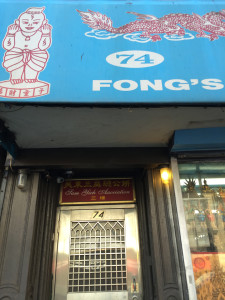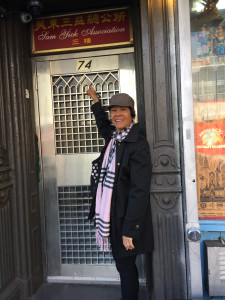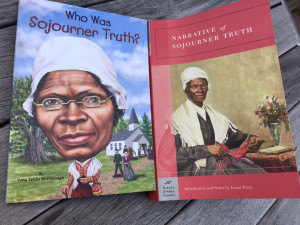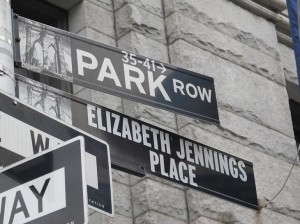
Finding Sojourner Truth’s former residence at 74 Canal Street in New York City’s Chinatown was a fun find. She was a domestic worker and attended churches on John, Duane, and Church streets. The noted feminist also worked at a women’s shelter on Bowery, according to NY Historical Society records.
In honor of Women’s History month I chose to focus on two of my favorite New York women—Sojourner Truth and Elizabeth Jennings. The more I learned about these women the more I asked myself– Where are their biopics? And who would play them? The world needs their stories! As a Lower Manhattan resident, I feel proud that this community was once New York’s original black community. This is holy ground! The African Burial ground is nearby too. As a genealogist, I’m always digging in local archives and strolling through the neighborhood in search of African American and women’s history.

Queen of reinvention
Sojourner would have been the queen of reinvention had she lived today! Born a slave in 1797 in upstate New York, Isabella Baumfree was the twelfth child of her enslaved parents James and Betsey. She went on to become America’s most famous abolitionist and women’s rights activist. Most of her siblings had been sold away by their Dutch enslavers. Like her father, she was over 6 feet tall. ‘Baumfree’ is a Low Dutch word for ‘tall tree.’ Sojourner, known as Belle, actually ‘freed’ herself at 32 years old. Friendly with local Quakers who abhorred slavery, Sojourner used her networking skills to move herself and one of her four babies to New York City in 1829. She lived in NYC fourteen years. But in 1843, at 46 years old, she got a ‘call from God’ to ‘go east.’ She woke up and reinvented herself again. She boarded a ferry to Connecticut, changed her name to Sojourner and became a traveling preacher. She also lived in Northampton, Massachusetts for many years. Sojourner finally moved to Michigan where she joined family members. Over a thousand people attended Sojourner’s funeral when she died at 86 years old.
You can view Sojourner’s famous image on display at the Met- NYC’s Metropolitan Museum of Art. The photo that she sold to earn money for her many human rights causes is emblazoned with her words: “I sell the shadow to support the substance.” To see the image, click here.
To learn more about Sojourner’s life in Ulster County, New York, click here
Surprisingly, both Sojourner and Elizabeth Jennings had famous public transit court cases 100 years before Rosa Parks was born!

Sojourner books to read
I picked two Sojourner books to read during Women’s History Month: A children’s book–Who Was Sojourner Truth? By Yona Zeldis McDonough, Penguin Young Readers Series and an adult book– Narratives of Sojourner Truth with ‘Book of Life’ and ‘A Memorial Chapter’ with an Introduction and Notes by Imani Perry; George Stade, Consulting Editorial Director, Barnes & Noble Classics, New York.
Sojourner dictated her ‘Narratives’ to feminist, abolitionist friend Olive Gilbert in 1850, whom she paid a fee for her services. This book was not an easy read as Gilbert inserted a lot of interpretive language. But it is full of amazing details. Sojourner explained why the horrific ‘unnatural’ acts that happened during her life in slavery are left out of her book. She crafted her own story and also kept a scrap book full of letters and news clippings, some of which is included in this “Narrative’ in a section called ‘Book of Life.’
Be surprised by lessor known facts
You will learn some differences between New York and Southern slavery. Mostly, you will be surprised by lesser known facts. For instance, I was shocked to learn that Sojourner was illiterate. Yet, her books, speeches, photo, and autograph were her bread and butter! Colorful details from her successful court cases and her dramatic and comedic testimonies would surely make an exciting film. Another surprising fact was that Dutch was her first language and that she spoke with a Dutch accent. The backstories to Sojourner’s famous quotes — “Ain’t I a Woman” and “What women want” are inspiring too.
Elizabeth Jennings
There are no books on Elizabeth Jennings. I learned about her during a Harlem church sermon. Elizabeth’s background was the opposite of Sojourner. Yet, their missions were the same. Both women were courageous and outrageous in their own way!
Jennings was rich, educated and born free during a time when most black folks were enslaved, illiterate and impoverished. Jennings is fairly known from her public transit court case. Although there is a street named for her in Lower Manhattan, few of my feminist colleagues have heard of Elizabeth Jennings.

Her wealthy father was apparently the ‘tailor to the stars’ and on the Board of the original Abyssinian Baptist Church. Close friends of Frederick Douglass, her parents were friends of successful white and colored entrepreneurs, politicians, skilled tradesmen and women and abolitionists. We rarely hear about New York’s earliest colored settlers and abolitionists like the Jennings. Mr. Jennings held a patent for renovating clothing and operated a very successful shop on Church Street. Elizabeth was privileged, educated, trained in music and worked as a teacher at a school for colored children.
Here’s an excerpt from my blog post archives about Elizabeth Jennings:
About 100 years before Rosa Parks, Elizabeth Jennings refused to get off a horse-drawn streetcar in New York. Think of Miss Jennings as a ‘Rosa Parks’ with a New York attitude. Not only did the 24 year-old teacher and church organist refuse to get off the horse-drawn streetcar, but she fought the driver, conductor and policeman, reminded them of her rights, sued them and the transit company and won! To reach more, click here.
- 73 Nassau Street (1829-30)
- 177 Duane Street (1830-31)
- Fourth Street, Franklin Street, Third Street (1830s)
Who are your favorite women who should be honored for Women’s History Month? Whose biopic would you like to see?